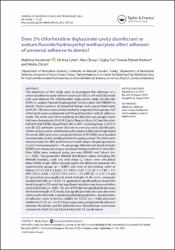| dc.contributor.author | Kuşdemir, Mahmut | |
| dc.contributor.author | Çetin, Ali Rıza | |
| dc.contributor.author | Özsoy, Alev | |
| dc.contributor.author | Toz, Tuğba | |
| dc.contributor.author | Öztürk Bozkurt, Funda | |
| dc.contributor.author | Özcan, Mutlu | |
| dc.date.accessioned | 2020-07-16T07:34:19Z | |
| dc.date.available | 2020-07-16T07:34:19Z | |
| dc.date.issued | 2016 | en_US |
| dc.identifier.citation | Kuşdemir, M., Çetin, A. R., Özsoy, A., Toz, T., Öztürk Bozkurt, F. ve Özcan, M. (2015). Does 2% chlorhexidine digluconate cavity disinfectant or sodium fluoride/hydroxyethyl methacrylate affect adhesion of universal adhesive to dentin? Journal of Adhesion Science and Technology, 30(1), 13-23. https://dx.doi.org/10.1080/01694243.2015.1087256 | en_US |
| dc.identifier.issn | 0169-4243 | |
| dc.identifier.issn | 1568-5616 | |
| dc.identifier.uri | https://dx.doi.org/10.1080/01694243.2015.1087256 | |
| dc.identifier.uri | https://hdl.handle.net/20.500.12511/5503 | |
| dc.description.abstract | The objectives of this study were to investigate the adhesion of a universal adhesive used either in total-etch (TE) or self-etch (SE) mode with and without 2% chlorhexidine digluconate cavity disinfectant (CHX) or sodium fluoride/hydroxyethyl methacrylate (NaF/HEMA) to dentin. Dentin surfaces of extracted human non-carious third molar teeth (N = 18) were exposed and randomly assigned to two groups. Half of the teeth were conditioned with TE and the others with SE adhesive mode. The teeth were then randomly divided into two groups where half were cleaned with 2% CHX (Cavity Cleanser, Bisco, CC) and the other half with NaF/HEMA (Aqua Prep F, Bisco, APF). Control groups in TE (C1) and SE (C2) adhesive system did not receive any cavity disinfectant. Dentin surfaces were conditioned with universal adhesive (Single Bond Universal, SBU) and resin composite blocks (3 M Z550) were bonded incrementally on the conditioned dentin using a mold. The teeth were stored in water for 48 h, and from each tooth, beam-shaped specimens (1 mm2 ) were prepared (n = 14, per group). Microtensile bond strength (MTBS) was measured using a universal testing machine (1 mm/min). Data (MPa) were analyzed using one-way ANOVA and Tukey’s test (α = 0.05). Two-parameter Weibull distribution values including the Weibull modulus, scale (m), and shape (0 ) values were calculated. Mean MTBS results (MPa) showed significant difference between the experimental groups (p = 0.001) and were in descending order as follows: C1-CC (32.8 ± 6.4)a<C1 (24.4 ± 5.2)b < C2 (21.1 ± 4.8)b < C1- APF (19.3 ± 4.4)b < C2-CC (14.1 ± 4.1)c < C2-APF (8.1 ± 2.1)d . C1 and C2 presented non-significant bond strength of the resin composite bonded with SBU (p > 0.05). CC application significantly increased the bond strength in TE mode, but significant reduction was observed when used in SE mode (p < 0.05). The use of APF did not significantly decrease the bond strength in TE mode, but significant reduction was observed when used in SE mode. Considering Weibull parameters, characteristics of adhesion seem to be less reliable for C2-CC (m = 3.86) and more reliable for C1-CC (m = 6.77). Failure types were predominantly adhesive between the dentin and the adhesive resin. Mixed failures were more common for both C1 and C2 and total etch-CC combination. | en_US |
| dc.language.iso | eng | en_US |
| dc.publisher | Taylor & Francis | en_US |
| dc.rights | info:eu-repo/semantics/openAccess | en_US |
| dc.subject | Adhesion | en_US |
| dc.subject | Adhesive Resin | en_US |
| dc.subject | Cavity Disinfectant | en_US |
| dc.subject | Chlorhexidine | en_US |
| dc.subject | Universal Bond System | en_US |
| dc.title | Does 2% chlorhexidine digluconate cavity disinfectant or sodium fluoride/hydroxyethyl methacrylate affect adhesion of universal adhesive to dentin? | en_US |
| dc.type | article | en_US |
| dc.relation.ispartof | Journal of Adhesion Science and Technology | en_US |
| dc.department | İstanbul Medipol Üniversitesi, Diş Hekimliği Fakültesi, Restoratif Diş Tedavisi Ana Bilim Dalı | en_US |
| dc.authorid | 0000-0003-3460-4382 | en_US |
| dc.authorid | 0000-0001-9589-3232 | en_US |
| dc.identifier.volume | 30 | en_US |
| dc.identifier.issue | 1 | en_US |
| dc.identifier.startpage | 13 | en_US |
| dc.identifier.endpage | 23 | en_US |
| dc.relation.publicationcategory | Makale - Uluslararası Hakemli Dergi - Kurum Öğretim Elemanı | en_US |
| dc.identifier.doi | 10.1080/01694243.2015.1087256 | en_US |
| dc.identifier.wosquality | Q3 | en_US |
| dc.identifier.scopusquality | Q2 | en_US |


















